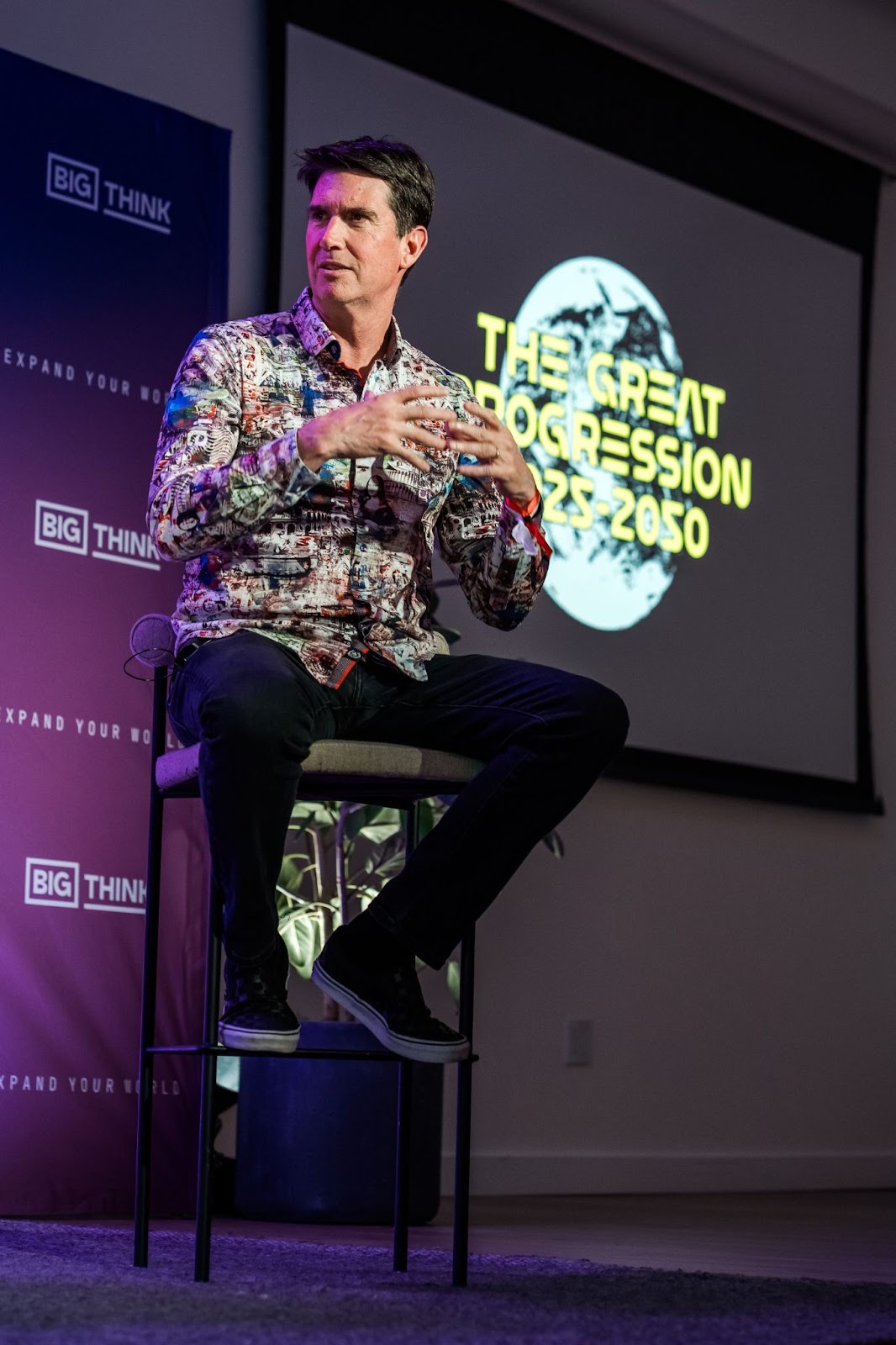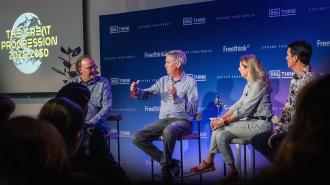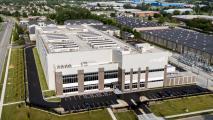Nobody’s as smart as everybody. That was my mantra when I moved to the San Francisco Bay Area as a young nobody 30 years ago, and I still believe it to this day.
Back then, working with the founders of WIRED, I would seek out the pioneers of the nascent internet and the early innovators of the digital revolution to help explain what was really happening around us and, more importantly, where it could all go.
I didn’t stop after those heady days in the 1990s, either. Over the past three decades, I have consistently found ways to convene leading innovators on the forefront of every meaningful tech iteration that we’ve seen. I’ve held dinners and workshops and one-off conferences — whatever it took to get everyone to compare notes and learn together.
In the last decade, I have found that the best way to accelerate this learning process is through ongoing event series. These provide the space for a network of innovators to regularly convene, giving them time to deepen their relationships and figure out the new ways forward together.
So, with the arrival of artificial intelligence and several other transformative new technologies, including bioengineering, I just launched a new physical event series in San Francisco that adopts the framework (and name) of my Substack series and upcoming book: “The Great Progression: 2025 to 2050.”
I’m the host and curator, but I am working with two key partners in order to make this quarterly series as impactful as can be.
Freethink Media is producing the series and videoing the programs to share on its publications, Freethink and Big Think. I’m excited to be working with Freethink because their mission is to reimagine media for a world defined by change, much like what we did at the original WIRED. That means they really try to live up to their ideals and approach their reporting with curiosity and openness. They believe that constructive discourse is the only way we make progress — a critical counterpoint to much of today’s media, which stokes division, negativity, and fear.
The other key partner is Shack15, the relatively new club where we are holding the events. This gathering spot for GenAI builders and many global visitors is located at the top of the iconic Ferry Building, overlooking the Bay at ground zero for AI and all things tech in San Francisco.
We kicked off the quarterly series on May 29, with about 250 members of the region’s tech and innovation economy jammed into the club and others on waiting lists. We cross-fertilized the relatively younger networks of Freethink and Shack15 with the veterans who I have come to know over the past three decades. The short video above gives you a quick sense of what we were attempting to do.
I invited three of the most thoughtful pioneering founders in my circles — Adam Cheyer, Steven Johnson, and Ryan Phelan — to help me start this important and timely conversation about how to make the most of AI and other transformative technologies over the next 25 years.
A key theme of the event series (and the corresponding book and Substack series) is exploring how we could best harness these transformative technologies to drive progress, reinvent America, and make a much better world. After laying out my overview of what might now be possible, I then interviewed all three guests on stage to find out what they thought.
Cheyer, co-founder of the pioneering startup Siri, which Steve Jobs personally sought out to buy so that its technology could be included in all iPhones, explained how the whole field of AI had advanced over the last 40 years, culminating in the breakthrough of generative AI less than three years ago, which surprised even AI experts like him. Cheyer, who has founded five startups over the years, helped us understand what humans might be able to do with AI to advance and accelerate our collective intelligence.
Johnson, author of a dozen books and co-founder of Google Lab’s smash hit NotebookLM tool, talked about how that tool alone can dramatically improve his productivity by allowing him to complete certain book-writing tasks anywhere from 10 to 100 times faster. He speculated on how all knowledge workers might be able to see big productivity boosts very soon.
Phelan, co-founder with the legendary Stewart Brand of Revive and Restore, a pioneering organization using cutting-edge bioengineering tools to protect endangered species (and maybe one day resurrect extinct species), broadened the conversation beyond AI to the potentially positive impacts of these new tools on all species on the planet. Phelan reminded everyone what we are up against with climate change and speculated on how bioengineering might help us solve our many daunting challenges.
I learned much from my individual interviews on stage with each of these founders and during a collective conversation among all three as well as all the innovators in the room, which then rolled into a party. I think you might learn something, too.
So, I went through the interview transcripts and pulled out some of the interviewees’ most interesting insights, which you can now read in their own words below. I will circulate their full video interviews in the next few weeks, and I expect to incorporate their ideas in some of my upcoming essays. For now, check out these key passages that start to point the new way forward for us all.
Adam Cheyer on the surprise arrival of AI and the prospects for superintelligence

On his astonishment when he first saw generative AI burst on the scene:
I’ve been an employee working on AI for almost 40 years now, back to the ’80s and expert systems. I had a prediction of how the field was going to evolve, how we’d get better at this and smarter at that, but seeing generative AI — my mind melted.
I came at generative AI with a very technical human bias: “Oh, it’s all probabilities.” It can write a love poem, generate, word by word, an entire poem, but it doesn’t know what love means — then I realized I was wrong.
It turns out, after decades of people wondering how do you type in common sense knowledge or acquire knowledge to know everything that we humans know, instead, by trying to predict the next word, a model of understanding for the entire world — every field, every concept, every relationship — fell out as a side effect.
I think even those working in this field had no idea that that was necessary to accurately predict the next word. So, for me, the holy grail of AI just popped out with no one expecting it or really conceiving of it.
So, now, does AI understand love like a human does? No. It can’t feel. It can’t understand those emotions exactly, but it knows everything about love and what it means and what relationships are. And not only love — it knows every major concept of every major field all at the same time. It is an expert in physics and mathematics and poetry and history and love all at once in one system and one model that can make connections and reason across all of it.
It was the biggest shock of my entire life.
On his most recent AI startup, GamePlanner.ai, which was acquired by Airbnb in 2023:
We were building tools to help humanity make better decisions together. We were combining three things, and you can think of it as bringing all the threads of my career together.
There was AI, like I did with Siri. There was UI, user interface — what’s the right experience for making decisions? And there was CI, collective intelligence, and we were trying to build what we called a “game plan” to help people work through.
It was a new document type, think “PowerPoint for decision-making,” which is an incredibly empty space. If I say “balance a budget,” you think “spreadsheet.” But if I say “we have an important decision to make,” what tool do we use? Nothing.
We were trying to fill that void with a game plan to literally help every individual, every company, every non-profit, every government come together and work through the biggest problems with the help of AI.
On the prospects of AI superintelligence in some domains, but not generally:
AlphaGo, which was from Google, trained on human’s best games, and how to play the game Go, and it achieved human-level expertise. It beat Lee Sedol, one of the top Go players ever.
But then there was AlphaGo Zero, not trained on any human games. It just knew the rules but had no prior notion of strategy. But it played 10 million, 10 trillion times, and AlphaGo Zero did evolve its own superintelligence for that one domain that was substantially better than humans, never having bothered with the input of that puny human knowledge.
I do believe that humans are special. Every single person in this room has capabilities — in fact, even children have capabilities — that no computer, no AI has or will have probably in my lifetime, or 2050, so I do think they’re complements.
On the possibilities of driving progress and creating a much better world off AI:
No matter how smart AI gets, it’s not going to solve all our problems by itself. And when I’m talking problems, I mean the big things like energy, hunger, poverty, war, pollution. There are big, wicked systemic problems, and AI’s not going to solve them — we have to do it….
In terms of optimism, I do think there are challenges coming, but I believe… every individual here has to imagine the desirable future you want to live — like who you want to be, what you want to do, what the perfect life would be — and go after it.
I believe in the power of persistence and imagination, and if you extrapolate that to a society, we need to imagine the Golden Age and, collectively, we need to come together and say, “How do we get there?”
I am an optimist in the special ability of humans to pursue a beautiful vision and, through persistence and creativity that we possess, get there.
So, overall, I’m an optimist. But it’s not going to be easy.
Author Steven Johnson on what he has learned about AI in co-founding Google’s NotebookLM

On his cover story in the New York Times magazine in the spring of 2022 that explained generative AI to many for the first time:
I got access to GPT-3, which wasn’t publicly available at that point in October of ’21, and I was like, “I at least have to know how this thing works.” I sat down with it, and I remember so vividly it was like the first time I saw the web in 1993 or ’94 — very similar. I got access to GPT-3 and was like, “Oh, shit, this is so much bigger than I realized.”
I wrote a 10,000-word piece about how computers are mastering language in a true, almost innate way and that is going to change everything about computing and a whole host of things are going to become possible.
And, yes, there are problems. Yes, it hallucinates. Yes, there are alignment issues. Yes, there’s safety issues. There’s a whole host of things to figure out, but what this is not is hype. What was clear to me then is that we have to take this seriously.
On how knowledge workers will see productivity boosts from what his team at Google Labs created in NotebookLM:
To the extent that your work as a knowledge worker involves synthesizing information that is scattered across multiple documents or 300 open tabs — like we all have on our browsers — and trying to find that information or remember that information or put together the facts in a new way so that you can share it with other people, then NotebookLM will boost your productivity.
That’s a huge part of what knowledge work is, and whatever field you’re in, where you’re moving bits around in your mind, NotebookLM will help.
There’s underlying AI, but also there’s the right UI, user interface, the right surface that you use to interact with it, and chat is only a part of that. That just feels like a very general purpose kind of problem that we’re trying to solve.
In the early days of NotebookLM, we would often ask, “Who is it for? What’s the target? Is this for students? Is this for nonfiction authors? Pick a lane.” And we were always saying, “We don’t really want to pick a lane. It feels like a pretty broad avenue. This tool is going to be useful for lots of different lanes.”
On how AI might evolve his ideas from his best-selling book “Where Good Ideas Come From: The Natural History of Innovation”:
One of the things that was important in “Where Good Ideas Come From” is connecting ideas across disciplines and finding serendipitous connections that drive innovation. Where you’re like, “Oh, I borrowed this idea from this field, and I melded it with this other field here.” And the whole history of innovation is about that kind of cross-pollination between fields.
That’s one of the places I spend a lot of time in my interactions with NotebookLM — making those kinds of connections. I’ll load up a bunch of information and I’ll say, “What is the most surprising fact in this information? What’s the thing that, knowing what you know about me, will surprise me, will expand my horizons in some way or make some new conceptual link that I wouldn’t have been able to make without the AI introducing me to this idea?”
And I see very promising signs in that way, so I’m starting to use it more as a creative augmentation tool and not just “organize my timeline for me.”
On whether a superintelligent AI could write a Steven Johnson-style book in five years:
If you can generate a podcast now that’s quite convincing and sounds like it might be on NPR with one click in NotebookLM, then is there a future where there’s a one-click “Write me a Steven Johnson book on this topic. I like his style. Just figure it out”?
I think, crazily enough, that is an imaginable future now. And the way that I think about what it would mean to get to that future is that the fate of nonfiction authors like myself will be the least of our problems.
It will mean that we will have invented something profoundly close to superintelligence. Not that I’m superintelligent, but it would be an amazing kind of leap to be able to build an entire 300-page book of historical research autonomously in 10 minutes.
So, if it has that capability, then all of society will have to be restructured. I don’t worry too much about me in that scenario. I worry more about the rest of us.
On whether AI is even capable of superintelligence and the implications of the answer:
I think there’s a huge fork that we’re right at the cusp of, and there’s a big debate about which way we’re going to go on this fork. And the fork is: “Is this crazy exponential growth in intelligence that we’ve seen over the last three years just going to continue?”
Are we going to get to self-improving AI that can program ever-more-intelligent AI, and we suddenly have this kind of escape velocity where the machines are genuinely smarter than any human on the planet?
In that future, if that future comes in five or 10 years, then I really think it is impossible to say what life will be like in 20 years. It’s unthinkable.
But I think it’s a genuinely open question whether that fork is possible. The thing I think that isn’t said quite enough about AI, where we are with AI right now, is that AI is fundamentally trained on the outputs, mostly the words, of some of the smartest human beings on the planet.
So we have seen, as that training process has actually started to really kick in at scale, that the models are asymptotically approaching the intelligence of some of the smartest people on the planet.
But what they are not trained on are superintelligent humans. That’s not in the training data. And it is not clear to me, and I don’t think it’s been proven yet, that you can just keep powering through that once you go past the limits of the smartest humans out there.
Now, obviously, the AIs will have better memory. They will understand more of different disciplines. But will that lead to a real fundamental step change, a paradigm shift in the kinds of intelligence that are possible?
I don’t think we know that yet. And if that is not the case, and if we have more of a linear development, then I think we have a good, optimistic future that we can feel confident about, and things will get better, and these tools will just augment our intelligence and won’t completely replace us or annihilate us or whatever our fears are. That’s the unknown.
Ryan Phelan on how bioengineering could be used to help solve climate change and the sixth mass extinction

On what she has been doing since co-founding her pioneering bioengineering organization in 2012:
Long story short, I run Revive & Restore with a great team of seven people and about 400 conservationists, genome engineers, and field biologists, all working in what we call the field of genetic rescue, helping species move away from the brink. And we’re using all the tools of technology, from genome sequencing to advanced reproductive technologies like cloning to genome editing.
On how saving the coral reefs from warming oceans and climate change will take intervening with bioengineering technologies:
The projection is that 90% of the coral reefs will be gone by 2050. Now, that’s if we don’t intervene. One of the biggest challenges in this conservation field has been whether or not traditional conservation biologists, field biologists, would be willing to intervene. When Revive & Restore looked at this field in 2015, I spoke with marine biologists all over the world, and they said, “There is so little coral being left on the reefs, we don’t dare intervene.”
And I then started talking about genome engineering. What if we could find coral that were more resistant to warming waters and transplant them to another place, like selective breeding is done? Or could we genome engineer? Could we find particular regions of the genome that are making them more thermal-tolerant?
So fast-track forward. Now we’ve been working with coral on some 13 different projects around the world. We fund the researchers to do this cutting-edge research, and more and more and more coral biologists are saying, “We have to do something. Standing by and doing nothing is not working,” and that “inaction is going to deplete the coral.”
A billion people count on coral reefs for their livelihood. The reefs protect our infrastructure all over the world. They dissipate wave action and hurricanes. And so when I think about this whole environment of how challenging it is for a species on the planet, we have to figure out how we can apply new technologies.
On how synthetic biology and the production of cultured meat and fish via cellular agriculture could make a big positive impact on the environment:
The number one problem that we have right now with humans encroaching on nature is land use for agricultural purposes, and if we can find a way to take the pressure off of land use — they call it “land sparing” — to help with environmental problems, it would be a boon to civilization in the future.
Now that doesn’t mean that all cattle are bad and that we can’t coexist, but we have to find a way to reduce that impact, whether it’s for carbon emissions or for just the healthiness of our planet.
Cellular agriculture — using synthetic biology for meat production and consumption — could be a very, very big deal if we can get a big enough market, if they can improve the products so that, as consumers, we all feel really good about it, and if the regulatory path in the United States in particular, as well as in Europe, actually finds a way to allow cell-based meats to go forward.
Now the same is true for aquatic species. So right now, a huge percentage of the fish that we eat — I think it’s almost 60% — is all done by aquaculture. So this is not a new terrain for us to be figuring out how to bring farmed fish to market, but to actually be able to do it using synthetic biology — to create cell-based fish and other marine species — is huge. It would be incredibly friendly to the environment.
On what it would take to realize the potential game-changing impact of genetic engineering on a level like what we’re seeing with AI:
I think we’re not at that inflection point with the Moore’s Law in biotechnology, but I think with AI we could be. I think AI is the big game-changer here.
I think CRISPR and the follow-on technologies with genetic editing are going to be key. I think the reproductive technologies are going to be important, just like they have been for human medicine.
When we look at what were some of the game-changers in healthcare in the past, one was in vitro babies. There was a time when we didn’t know what to do with the issue. It was ethically fraught. The first births were called “test tube babies.” Probably some of you are the result of in vitro fertilization, or you certainly know people who’ve had children because of that technology.
I think that’s going to happen in genetic engineering, and we’re going to eventually take it for granted. In vitro fertilization was not regulated, and I think we’re going to have to find ways to solve this regulatory burden that exists around genomic medicine now, too.
We’d love to hear from you! If you have a comment about this article or if you have a tip for a future Freethink story, please email us at [email protected].






